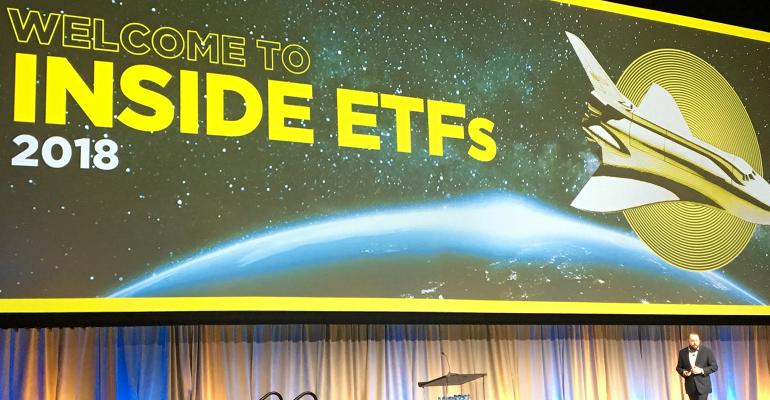Every year, Inside ETFs CEO Matt Hougan and ETF.com CEO Dave Nadig take the stage at the Inside ETFs conference and give their take on the state of the industry, and every time, like an upbeat song on repeat, it’s a litany of success: revolutionary products, blowout record-breaking inflows, and fees, already cheap, getting even cheaper.
But this year, with attendance at the conference setting a record of its own with over 2,400 asset managers and financial advisors, the two CEOs admitted things felt different, with market valuations frothy just as 2017 inflows into the largely passively managed funds continuing to shatter records at a whopping $500 billion. In fact, Hougan himself said he reduced his equity exposure by 10 percent; Nadig by 5 percent. As the market conversation turns toward overvalued equities and the dangers of passively investing in them, the duo posed an existential question—can there be too much success in ETFs?
Their anxiety may, in fact, be misguided, Nadig argued. If you consider the future of ETFs as not just another item on investors’ menus, but rather the entire meal, the success they’ve had in the market is minuscule compared to the opportunity. The growth of the ETF space is not linear, but rather exponential, Hougan said, and will have little trouble eclipsing mutual fund assets by the year 2025.
“This isn’t inning number six or seven in the ETF industry; it’s inning number two or three,” Hougan said. “There are huge parts of the market where investors are being overcharged and effectively ripped off for exposures and returns we now know can be systematically driven on a rules-based basis in extremely low-cost portfolios.”
Hougan pointed to three multi-trillion-markets that ETFs will disrupt over the next five years, the first of which is hedge funds, which typically charge two percent of assets and 20 percent of returns. But innovative asset managers are beginning to package hedge fund strategies in ETF wrappers.
“Let me tell you quickly about maybe one of the most sophisticated hedge funds in the world,” Hougan said. “It uses natural language processing and artificial intelligence to read every available data source. It scores the news that it’s digesting on the likelihood for a merger activity to take place. It then hires a team of PhDs and quant analysts to scour through those scores, identify long and short positions, pair them into a merger arbitrage portfolio that should deliver 3, 4, 5 percent returns to replace your fixed income exposure. It does all this—not at 2 and 20. It does all this in an ETF charging 85 basis points with intraday liquidity.”
Private equity is another market where it will be increasingly difficult to justify the traditionally large fees and lock-up periods when similar exposures can be found in liquid, low-cost ETF wrappers.
And finally, Hougan said, there are individual stock portfolios in separately managed accounts that would be far better served by the technology behind ETFs.
Combine the three, and ETFs have a long growth path ahead, he said. The global market of equities, fixed income and alternatives accounts for $150 trillion in assets. Yet ETFs have just $5 trillion globally.
Supporting the claim is the nature of the ETF market, Nadig said. The share of value traded on the markets accountable to ETFs is actually falling, and now accounts for 25 to 30 percent on any given day.
“It means that this is no longer a trader’s vehicle,” Nadig said. “That means that it’s long-term investors that are using ETFs for all sorts of things, not just trading.”
And while index investing reduces the market’s ability to single out and punish a poorly run company, there is an opportunity for the largest index investors to take a more active role in advocating for shareholders at the corporate level. “If (index investors) don’t like what a company is doing, if they don’t like how they responded to an environmental disaster, if they don’t like how they’re treating their board, if they don’t like their labor policies, they can’t sell. What they can do is vote.”
State Street, for example, voted against 400 companies’ re-election plans because of a lack of gender diversity; BlackRock CEO Larry Fink sent a letter excoriating the leaders of thousands of public companies for their short-term thinking. Advisors and clients have a direct stake in this, Hougan said.
“You need to stop looking at S&P 500 ETFs and just asking, ‘Which one is 1 basis point cheaper?’” he said. “You actually need to start looking at those and asking, ‘How are these companies voting their shares?’ And you need to look at the ones that align with your beliefs and your clients’ beliefs, and you need to reward them with your assets.”





